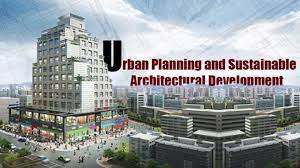Urban Planning and Sustainable Architectural Development
Urban Planning for Better Human Settlements:
Planning in general is the scientific method that aims to provide solutions or alternatives to the current or expected problems of society within the framework of an organized plan with clear policies and objectives, within a specific time period. It takes into account the possibilities and resources as well as the current or future determinants, whether human or natural.
Urban planning which is a technical and political process concerned with the development and design of land use and the built environment to achieve strategic, political and sustainability goals. The study of urban planning is used by planners working in the cognate fields of architecture, landscape architecture, civil engineering, and public administration in order to achieve a balance between the development needs of the present while taking into consideration the stability and the effects it has on the future (i.e. achieving a sustainable development).
Urban planning is considered an interdisciplinary field that includes social engineering and design sciences. It is related to the field of urban design and some urban planners provide designs for streets, buildings, parks and other urban areas. Urban planning is referred to by many terms as urban and regional planning, regional planning, city planning, town planning, rural planning, urban development or some other combination.
Sustainability and Development to Achieve a Better Present and Future:
Taking into consideration all the aspects of the environment, landscape and the community is what leads to the concept of sustainable urban planning. Sustainability is the ability to exist constantly. The concepts of sustainable design, green architecture, sustainable construction and green building are all new ways of design and construction that stand in the face of the environmental and economic challenges that have cast a shadow over the various sectors of this era. The new buildings are designed to reduce environmental impact while also reducing costs, in particular running costs.
It also contributes to a safe and comfortable urban environment, thus, the motivation for adopting the concept of sustainability in the urban sector is no different from the motives that led to the emergence and adoption of the concept of sustainable development with its interconnected environmental, economic and social dimensions.
The developed countries are more interested than the developing nations in improving the urban environment from the planning period through the design and implementation of the urban projects and the continuation of the stages of management and maintenance, development and development of the human aspect in it. In most developing countries, it is considered that the responsibility ends when construction projects are completed. According to the whims of the population, without a social organization that directs their local activity or protects their urban environment, these projects will turn socially backward, adding to the problems of the city a double burden.
Sustainable Architecture and the Environment:
Sustainable architecture seeks to minimize the negative environmental impact of buildings by efficiency and moderation in the use of materials, energy, and development space and the ecosystem at large. Sustainable architecture uses a mindful approach to energy and ecological conservation in the design of the built environment.
Sustainability is an idea to ensure that our use of available resources does not end up having damaging effects on our collective well-being or making it impossible to obtain resources for other applications in the long run. Which in turn meets the needs of the present without losing sight of the right of future generations to meet their needs.
Green Urbanism (GU) – International Conference
The 4th international conference on “Green Urbanism (GU)” is taking place in Rome, Italy, from 24 to 26 November 2020.
GU-2020 aims to bring together, scientists, urban planners, architects and other stakeholders from across the globe to discuss the latest research findings in all aspects of sustainability.
Moreover, GU international conference avails the opportunity for interested researchers, scholars, scientists, architects, and engineers from around the globe to submit their research papers and get them published in highly-ranked international journals by the esteemed publishers Springer and IEREK Press. Noting that submitted researches must be in the scope of at least one of the official conference topics and abiding the submission instructions.
Many critical topics will be discussed during the GU conference, such as:
- The Evolution of Green Urbanism
- Formulating the Principles of Green Urbanism
- Urban Design for Nature, Conservation of Natural Resources
- Passive Designs: Green Buildings for Sustainable Use
- Green Districts: Bike, Cycles, and Pedestrians’ Corridors
- Urban Growth of Developing Cities
- City Urban Form and Natural Resources
- Landscape, Gardens, Streetscapes, and Urban Biodiversity
- Urbanization of Rural Area: Energy, Water, and Food Security
- Urban Governance, Leadership, Best Practices, Research, and Awareness
- Green Infrastructure and Sustainable Environment
- Regeneration of the City Center and Urban Transit Hubs
- Waste Management, Pollution, and Health Risks
- Energy Efficiency in the Built Environment
- Effects of Sustainable Environments on Human Health
- Advancing Solutions towards Zero Waste Cities
- Transformation to Green Environment
For more information & registration, visit the conference’s official page: https://www.ierek.com/events/GU4th



